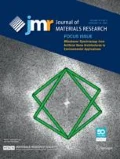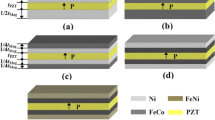Abstract
Magnetoelectric (ME) effect has been studied in bi-rectangular structure made up of epoxy-bonded negative/positive magnetostrictive and piezoelectric flakes. The ME effect is affected by negative and positive magnetostrictive flakes. The ME voltage coefficient at resonance frequency shows a nearly constant plateau behavior with the bias magnetic field increased from 1 to 3.5 kOe. There is no interface between magnetostrictive and piezoelectric flakes required to achieve ME coupling, which provides a new choice to make ME devices.




Similar content being viewed by others
References
Y.K. Fetisov, A.A. Bush, K.E. Kamentsev, A.Y. Ostashchenko, and G. Srinivasan: Ferrite piezoelectric multilayers for magnetic field sensors. IEEE Sens. J. 6, 935 (2006).
C. Israel, N.D. Mathur, and J.F. Scott: A one-cent room-temperature magnetoelectric sensor. Nat. Mater. 7, 93 (2008).
M. Fiebig: Revival of the magnetoelectric effect. J. Phys. D: Appl. Phys. 38, R123 (2005).
G. Srinivasan: Magnetoelectric composites. Annu. Rev. Mater. Res. 40, 153 (2010).
V.J. Folen, G.T. Rado, and E.W. Stalder: Anisotropy of the magnetoelectric effect in Cr2O3. Phys. Rev. Lett. 6, 607 (1961).
J. Ma, Z. Shi, and C.W. Nan: Magnetoelectric properties of composites of single Pb(Zr,Ti)O3 rods and Terfenol-D/epoxy with a single-period of 1-3 type structure. Adv. Mater. 19, 2571 (2007).
Y.M. Jia, H.S. Luo, X.Y. Zhao, and F.F. Wang: Giant magnetoelectric response from a piezoelectric/magnetostrictive laminated composite combined with a piezoelectric transformer. Adv. Mater. 20, 4776 (2008).
K. Bi, Y.G. Wang, D.A. Pan, and W. Wu: Large magnetoelectric effect in negative magnetostrictive/piezoelectric/positive magnetostrictive laminate composites with two resonance frequencies. Scr. Mater. 63, 589 (2010).
M.I. Bichurin, D.A. Filippov, V.M. Petrov, V.M. Laletsin, N. Paddubnaya, and G. Srinivasan: Resonance magnetoelectric effects in layered magnetostrictive-piezoelectric composites. Phys. Rev. B 68, 132408 (2003).
S.X. Dong, J.R. Cheng, J.F. Li, and D. Viehland: Enhanced magnetoelectric effects in laminate composites of Terfenol-D/Pb(Zr,Ti)O-3 under resonant drive. Appl. Phys. Lett. 83, 4812 (2003).
S.X. Dong, J.F. Li, and D. Viehland: Voltage gain effect in a ring-type magnetoelectric laminate. Appl. Phys. Lett. 84, 4188 (2004).
V.M. Laletin, N. Paddubnaya, G. Srinivasan, C.P. De Vreugd, M.I. Bichurin, V.M. Petrov, and D.A. Filippov: Frequency and field dependence of magnetoelectric interactions in layered ferromagnetic transition metal-piezoelectric lead zirconate titanate. Appl. Phys. Lett. 87, 222507 (2005).
K. Bi, Y.G. Wang, W. Wu, and D.A. Pan: The large magnetoelectric effect in Ni-lead zirconium titanate-Ni trilayers derived by electroless deposition. J. Phys. D: Appl. Phys. 43, 132002 (2010).
D.A. Pan, Y. Bai, A.A. Volinsky, W.Y. Chu, and L.J. Qiao: Giant magnetoelectric effect in Ni–lead zirconium titanate cylindrical structure. Appl. Phys. Lett. 92, 052904 (2008).
C.W. Nan: Magnetoelectric effect in composites of piezoelectric and piezomagnetic phases. Phys. Rev. B 50, 6082 (1994).
C.W. Nan, M.I. Bichurin, S.X. Dong, D. Viehland, and G. Srinivasan: Multiferroic magnetoelectric composites: Historical perspective, status, and future directions. J. Appl. Phys. 103, 031101 (2008).
Y.M. Jia, S.W. Or, K.H. Lam, H.L.W. Chan, Y.X. Tang, X.Y. Zhao, and H.S. Luo: Magnetoelectric effect in composites of magnet, metal-cap, and piezoceramic. Appl. Phys. A 86, 525 (2007).
M. Zeng, S.W. Or, and H.L.W. Chan: Giant magnetoelectric effect in magnet-cymbal-solenoid current-to-voltage conversion device. J. Appl. Phys. 107, 074509 (2010).
M. Zeng, S.W. Or, and H.L.W. Chan: Giant resonance frequency tunable magnetoelectric effect in a device of Pb(Zr0.52Ti0.48)O3 drum transducer, NdFeB magnet, and Fe-core solenoid. Appl. Phys. Lett. 96, 203502 (2010).
C.M. Leung, S.W. Or, S. Zhang and S.L. Ho: Ring-type electric current sensor based on ring-shaped magnetoelectric laminate of epoxy-bonded Tb0.3Dy0.7Fe1.92 short-fiber/NdFeB magnet magnetostrictive composite and Pb(Zr,Ti)O3 piezoelectric ceramic. J. Appl. Phys. 107, 09D918 (2010).
G. Srinivasan, C. De Vreugd, V. Laletin, N. Paddubnaya, M. Bichurin, V. Petrov, and D. Filippov: Resonant magnetoelectric coupling in trilayers of ferromagnetic alloys and piezoelectric lead zirconate titanate: The influence of bias magnetic field. Phys. Rev. B 71, 184423 (2005).
Acknowledgments
This work is supported by the National Natural Science Foundation of China under Grant No. 11174148 and the Natural Science Foundation of Jiangsu Province of China (Grant No. BK2010505) and the Funding of Jiangsu Innovation Program for Graduate Education (Grant No. CX10B_099Z). D.A. Pan would like to acknowledge support from the National Natural Science Foundation of China under Grant 50802008.
Author information
Authors and Affiliations
Corresponding author
Rights and permissions
About this article
Cite this article
Bi, K., Wang, Yg., Pan, Da. et al. Magnetoelectric effect in a bi-rectangular structure composed of negative/positive magnetostrictive and piezoelectric flakes. Journal of Materials Research 26, 2707–2710 (2011). https://doi.org/10.1557/jmr.2011.258
Received:
Accepted:
Published:
Issue Date:
DOI: https://doi.org/10.1557/jmr.2011.258




